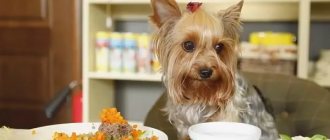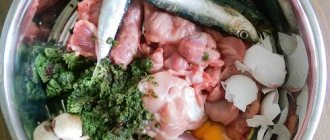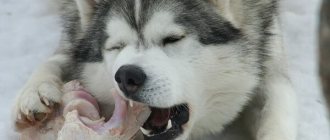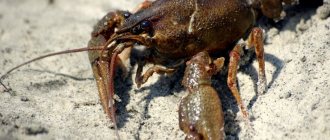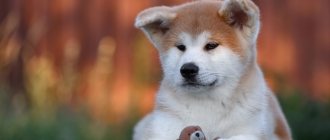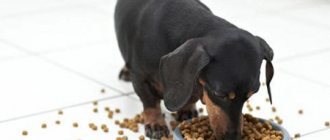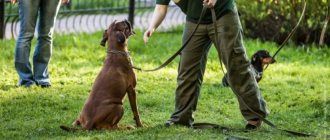What to feed on natural food
If the dog is accustomed to receiving natural food, it is important to pay attention to the products that make up its diet, their combination and the presence of additional necessary elements. It is also very important how the owner processes the food - cooks, freezes or serves it raw.
Dangerous! Frequently changing your pet's diet, constantly switching the dog from one food to another, changing and mixing branded and natural products, is dangerous for the health of your four-legged friend!
If your pet feels well, it is better not to introduce innovations into its diet. If there are health problems, in addition to treatment with medications, it is often worth paying attention to nutrition. But only a doctor can prescribe therapy, including nutritional adjustments.
The basic rule of feeding natural food is the selection of suitable products, their proper preparation and selection of the optimal serving size. Feeding timing also plays an important role.
Is it possible and how to rinse a dog’s nose at home?
Adult dogs should be fed 1-3 times a day (preferably 2 times - morning and evening). Growing pets are fed according to their age:
- from 2 to 3 months – 5 – 6 times a day (every 3 – 4 hours);
- from 3 to 6 months – 4 – 5 times;
- from 6 to 12 months – 3 times;
- older than a year – 1 – 2 times.
The advantages of natural feeding are the high digestibility of nutrients contained in such food, as well as the variety of products and, accordingly, tastes. However, there are certain difficulties when feeding natural food: it is very difficult to find the optimal balance of all micro- and macroelements and nutrients. In addition, it takes a certain amount of time to prepare the food, and the prepared food does not last long. There is one more difficulty - it is necessary to add vitamin supplements to your pet’s food.
Beef is the best meat for a dog's diet.
How much food should you give your dog?
How to choose the ideal amount of food for your dog? It is necessary to consult with a specialist or carefully observe the behavior of the animal at the time of feeding.
If the dog quickly eats the offered amount of food and the bowl remains clean, then at the next feeding you can slightly increase the portion. If after 15-20 minutes some of the food remains in the bowl, then the next portion should be slightly reduced.
This is important: You should carefully monitor your four-legged friend. Many individuals are prone to gluttony. The result is excess weight, which negatively affects the state of the cardiovascular, musculoskeletal and other systems.
If you gain extra pounds, you should increase your dog’s physical activity and reduce the portion.
Meat in the diet
It is worth understanding that dogs are carnivores, so the main element of their diet should be animal protein. Only if such protein is present can the food offered to the dog be considered complete.
The digestive system of canines digests meat best, but not all types of meat products are equally suitable for your four-legged friend. The best option would be beef in any form, but now let's talk about this in more detail.
Beef kidneys, lungs, liver and meat
This is a good feeding option for your dog. This meat is rich in proteins, vitamins, macro- and microelements, and contains fats and ash. If we take into account beef by-products - liver, lungs, kidneys, heart - this is also a healthy food for dogs. The sinews and ligaments are well suited as treats. You can give your pet specially prepared ears, cartilage (dried, calcined, etc.), which are sold in pet stores, and you can also prepare similar treats yourself.
Chicken meat, necks, legs, stomachs and heads
Chicken is also a good choice for a dog. This is a nutritious meat that has long been considered dietary. Pets eat chicken fillet and offal very well; it contains many essential substances and is well digested. However, some dogs have food allergies to this type of meat, so it is sometimes more rational to replace chicken fillet with any other.
Owners often argue about feeding individual parts of the chicken - heads, paws, necks and others. To avoid any doubts, you can give your pet specially prepared necks, paws, and stomachs. You can purchase ready-made similar treats at pet stores, or you can independently remove all sharp, hard, fragile parts (claws, small sharp bones) and please your pet with similar treats. Tubular bones should not be given - dogs often choke on them, injure the digestive tract with fragments, and clog the stomach.
Turkey meat
Healthy meat for dogs, contains saturated fatty acids, ash, and many vitamins. The dog's body absorbs turkey meat well, this is a convenient option for feeding your pet. You should not choose turkey as the only type of meat to feed your dog; it is better to introduce a variety of meat products into the diet.
Rabbit meat
This tender meat is quite low in calories, contains a large amount of proteins, fats and vitamins (especially B vitamins). It is well suited for dogs, as it is easily digestible and pets like the taste.
Why you can’t often use pork and offal
You should not feed your pet pork too often. This product often causes indigestion, especially in dogs with gastrointestinal problems. The reason is the high fat content and some proteins that are not suitable for dogs. Sometimes you can feed your pet lean pork tenderloin, but pork is not suitable for constant feeding.
Pork offal is another matter. The same kidneys, lungs, heart and liver contain less harmful fat and are therefore better suited for natural feeding. At the same time, if it is possible to replace them with beef, it is better to do so. Then there will definitely be no problems with the dog’s gastrointestinal tract. Thus, pork meat and offal are allowed to be used infrequently for variety in feeding the dog and nothing more.
Marrow bone
Bones
Be careful when handling bones. You cannot believe fairy tales and cartoons that tell how dogs with appetite eat exclusively bones and this is good for them.
In real life, the situation is much different - not all bones are suitable as a treat for a pet, and certainly no bones are suitable as the main diet.
Often, incorrect feeding of bones harms the pet’s health, and sometimes becomes a serious threat to the dog’s life. This is because a dog, gnawing hard parts of a bone, leaves a lot of fragments, some of which can injure the pet’s mouth, and, worse, can be swallowed. Damage to the esophagus, stomach, and intestines due to sharp bone edges is often encountered. Obstructions occur, the treatment of which sometimes involves surgery.
To avoid such situations, you can give your pet to gnaw only on the bone that the dog cannot bite through, but only gnaw off the remnants of meat, cartilage and veins from it. You can saw the bone lengthwise so that the pet can get to the red bone marrow. If the pet is large, such as the Black Terrier, and easily bites through dense tubular bones, you should give preference to cartilage and ligaments, and it is better not to give natural bones at all.
It should be remembered that boiled bones are not digestible; only raw ones are suitable for delicacy. However, you need to be confident in the quality of this product.
Beef bones are good as a delicacy. Chicken can only be given to flat porous ones, which are quite soft and not spicy. Under no circumstances should you give fish bones.
Warning! Raw meat must be extremely fresh. It is important to store food in the refrigerator and constantly check the quality of the food.
Some expert advice
Despite the widespread belief about the benefits of raw foods, meat should be given boiled. Dogs eat raw fillet and offal well, but meat is less digestible in this form. But the main danger is infection with all kinds of pathogenic microorganisms, helminths (parasitic worms).
Give frozen raw meat with caution - low temperatures can affect worm eggs, but do not affect many dangerous bacteria. Dousing raw meat with boiling water before serving is even less effective, since in order to eliminate harmful microflora, exposure to high temperatures must continue for some time. Therefore, it is best to cook meat for dogs.
Under no circumstances should you feed your pet only meat. Such a menu will not be able to meet all the necessary needs of the dog’s body. You also need fiber, plant components, vitamins and minerals not found in meat products.
Sausage, frankfurters, smoked meats
Such fragrant and attractive treats should never be given to your pet. To prepare these products, a variety of spices and preservatives are used, which have a detrimental effect on the functioning of the dog’s body.
Often, due to such a diet, gastritis, digestive disorders, colitis, pancreatitis occur, and in more advanced cases, gastrointestinal ulcers (gastrointestinal tract). It is better to protect your pet by completely eliminating such products from his diet. If you want to pamper your beloved four-legged friend, it is better to choose special treats in a pet store or get by with natural products without spices and all kinds of additives.
Sea fish Fresh char
Eaters remain eaters
My own puppy likes to eat quickly and I really don't like this behavior. In fact, he attacks a regular dog bowl and finishes his small dog's 1/3 cup portion in about 8 seconds.
Yes, he has a slow feeder and I leave a food puzzle for her to use for treats when we leave her alone for a few hours. Still—and I realize I'm anthropomorphizing—I'm sad because she doesn't seem to truly enjoy eating. She is obsessed, never satisfied. It's like watching obsessive-compulsive disorder.
Did I mention she's overweight? It's really easy to overfeed such dogs because they always have that expectant expression on their face. Anyone remember Little Shop of Horrors? Well, my dog is little Audrey II. Her face constantly says, “Feed me.” She only lost 100 grams thanks to more exercise.
Article Author : Dr. Deborah Lichtenberg , a small animal and exotic animal veterinarian, has been practicing medicine for over 30 years. Graduate of the University of Pennsylvania School of Veterinary Medicine. Dr. Lichtenberg has been writing about dogs for many years and has been awarded Certificates of Excellence by the Canine Writers Association of America.
Raw fish and other seafood
Dogs need fish products for proper nutrition. Preference should be given to any type of sea fish, since it is better in terms of the content of useful substances, less bony and less likely to be infected with helminths than river fish.
The high content of vitamin D, B, magnesium, iodine and fats have a beneficial effect on the functioning of the nervous system, the body's immune strength and the condition of the pet's coat. Perfect for:
- salmon;
- pollock;
- pink salmon;
- saury;
- herring;
- whiting;
- sea bass.
The fish is fed exclusively in boiled form, having previously selected all the bones, removing sharp fins and other dangerous parts. You cannot feed your pet seafood every day; it is correct to include them in the menu 1 – 2 times a week or less. Raw fish should not be given at all!
Shrimp and crabs can be included in a dog’s diet, but in small quantities. Be sure to pre-boil them and thoroughly clean them of the shell and other sharp and dense parts. You cannot give shrimp heads, no matter how much the dog begs for them. This usually leads to vomiting. Mussels are of limited use and only boiled.
It would be a great idea to include seaweed in your dog’s diet. It contains a lot of useful microelements and is the main source of iodine. You can use both canned, without salt and seasonings, or dry. Dried seaweed must be soaked in hot water before feeding.
Low-fat cottage cheese
Vitamins
Supplements for dogs are usually available in tablet form. They have an attractive aroma and taste. For particularly picky individuals, multivitamin complexes in powder or drops are suitable.
This is interesting: 10 tips on how to accustom a puppy to dry food
They are mixed into food or water, and also applied to the animal’s tongue. The drug is selected on the recommendation of a veterinarian, taking into account the breed and its weight.
Calcium, phosphorus and phytin are needed by puppies and adults for the formation and maintenance of bone tissue. But constantly adding vitamins to your diet is not recommended. They should be given in courses with a break of 2 weeks to 3 months.
For dogs receiving natural feeding, dog handlers and veterinarians advise choosing natural mineral supplements.
But ready-made pharmacological preparations (yeast SFK, Canina, Welpenkalk) can provoke a histamine reaction or indigestion in the animal.
Dairy and fermented milk products
It is very important for dogs to get animal protein not only from meat, but also from other sources. The best and most accessible source is milk and products derived from it.
Directly pasteurized, steamed or boiled milk is not suitable for all puppies and adult dogs. In older pets, over time, the body stops producing lactase, an enzyme that breaks down lactose (milk sugar), which allows it to be absorbed.
Also, often the body of young puppies does not accept milk, and diarrhea, vomiting and other unpleasant symptoms of indigestion occur. Experts recommend replacing milk with fermented milk products, but if the dog accepts milk well, you can safely treat it with this product. It is important to feed fermented milk products:
- kefir;
- fermented baked milk;
- curdled milk;
- bifidocus;
- natural yogurt.
These drinks help digestion, the content of lactic acid bacteria improves the functioning of the gastrointestinal tract, and the necessary micro- and macroelements strengthen the immune system.
It is also important to enrich your pet’s diet with cheeses and cottage cheese. These products are good for metabolism, the body's resistance, help digestion and dogs really like the taste.
It is better to give kefir of medium fat content, if the dog accepts this product well, you can use fattier ones, if necessary, give low-fat ones (if the pet requires a diet), the same applies to other fermented milk drinks.
Advice! Chicken eggs are also a source of important protein for dogs. But at the same time, you need to follow the norm. They should be included in the diet in boiled or raw form, no more than 2-3 times a week.
Goat's milk is much better for dogs. As a rule, there is no allergic reaction to it at all. Unfortunately, goat milk is expensive and not everyone can afford it for their dog. This is the only reason why such milk is used for feeding a pregnant dog or feeding puppies up to the age of six months. In general, if the money issue does not bother you, there are no restrictions on goat milk for dogs, except for individual intolerance.
Barley porridge with meat broth
Useful tips
If your dog flatly refuses to eat fresh vegetables, then you can use a little trick. Lightly boiled or stewed vegetables may be to the taste of a picky four-legged pet.
Dog handlers advise excluding sweet, smoked, spicy, and salty foods from your pet’s diet. And under no circumstances should you mix natural menus and ready-made diets.
If absolutely necessary, the transition should be gradual so that the dog’s body can adapt. The duration of adaptation cannot be less than 14 days.
Cereals and porridges
It is impossible to imagine natural feeding of a dog without porridge. Indeed, cereals are an important component of a pet’s complete diet.
Dogs eat best porridge cooked not in milk, but in meat broth. As a rule, no one refuses such a dish.
But not all cultures are suitable for a pet’s body. Dogs are given:
- rice;
- oatmeal (or Hercules);
- buckwheat
You can also give, but in smaller quantities:
- barley;
- wheat;
- You can mix these types of cereals by boiling mixed porridge.
Rice and oatmeal contain natural mucus that coats the stomach and protects its mucous membrane. Often these cereals are prescribed to dogs suffering from gastritis and ulcers. Also, vitamins E, B, PP and others contained in these cereals replenish the reserves of essential substances for the body.
It is very good to give your pet buckwheat, as it contains vitamins, protein, and carbohydrates, which are very important for the dog’s full existence. Barley and wheat (not to be confused with millet) cereals are given less frequently, but these crops are quite suitable for feeding a pet.
Types of porridge that are not suitable for dogs:
- pearl barley;
- millet;
- legumes (peas, lentils, beans);
Such crops are either poorly absorbed by the dog’s digestive system, which is why they do not provide any benefit and pass through in transit, or, as in the case of legumes, they often cause bloating, flatulence, and colic.
You need to cook the cereal until the porridge becomes soft and homogeneous, but not overcooked. The lumps are kneaded, you can add a small amount of butter (no more than 1 - 2 times a week, the volume of the additive depends on the size of the dog, it should be approximately 0.1 - 0.5% of the total portion of food), but it is preferable to use vegetable oils - olive, flaxseed (their volume can be increased up to 1% of the serving volume). It is also good to give your pet fish oil, in capsules or liquid form, if necessary. You cannot add spices and seasonings to the porridge.
Bread, buns, pasta, dumplings and similar dishes are not given to dogs. Such a diet also often causes the activation of fermentative bacteria, which causes colitis, flatulence and other digestive problems.
Chopped vegetables
Conclusion
It’s not difficult to feed your dog natural food if you have the desire. It is only important, when preparing a diet for your pet, not to forget that you can feed it exclusively with good quality food, while compiling the menu in such a way that the dog receives from food all the nutrients it needs, as well as vitamins and minerals. Naturally raised dogs are usually distinguished by enviable health, they are cheerful, active and live long.
What foods do you feed your natural-fed pets? Or maybe you even have “signature” dishes specially invented for your pet? Write about it in the comments to this article. Share your opinions, tips and stories, as well as photos of your well-fed and happy pets eating natural food.
Vegetables and fruits
Vegetables are a source of many vitamins (A, D, E, PP, B and others), and they are also fiber, which is necessary for removing unnecessary substances from the gastrointestinal tract, improving peristalsis (successive movements of the stomach and intestines, which ensures the digestion and movement of the feed throughout digestive tract).
Despite the fact that pets are carnivores, dogs benefit from:
- carrot;
- zucchini;
- pumpkin;
- beet;
- apples (without skin);
- Bell pepper.
You can also give cucumbers and broccoli. Treat cabbage and tomatoes with caution in small quantities.
From fruits and berries, you can please your pet with apples, pears, bananas, watermelon, lingonberries, and blueberries. It is better to choose the least sour and sweet varieties.
All these products are fed raw, cut into slices, after thoroughly washing and removing seeds, cuttings and other unnecessary parts. Some breeders advise grating vegetables and fruits, but if your pet likes to chew and crunch such treats, it is better to give them in pieces.
It is prohibited to give dogs:
- mushrooms;
- avocado;
- strawberries;
- onion;
- garlic;
- potato;
- hot pepper;
- grapes and raisins.
Lettuce and parsley are also suitable for dogs. Dill is also suitable, but dogs often refuse to eat dill because of its pungent odor. It’s very good to add fresh nettle to your food, just don’t forget to pour boiling water over it first.
Bread
Ready-made feed
Ready-made food makes life easier for a dog owner. They have a number of undeniable advantages, but they are not always good quality food that adds health. Prepared feeds are often made from grains. The manufacturer, by introducing synthetic amino acids and vitamins, achieves a high level of proteins and vitamins, but this has nothing to do with natural food.
When buying ready-made food, the owner cannot independently determine the quality. Even laboratory tests cannot always determine the quality, much less the composition of the feed. This provides a wide field for falsification and introduction of all sorts of different things into the feed. The manufacturer (even of expensive food) often deviates from the presented recipe.
Ready-made feed:
- available (available in stores and in different price categories);
- easy to store;
- easy to feed;
- well eaten by dogs.
However, it is undeniable that finished feeds are made at high temperatures. This removes moisture and kills microorganisms. However, biologically active substances are also killed. The food becomes dead. Synthetic added substances cannot fully satisfy the needs of a dog’s body, especially a growing one.
Advantages
Dry food is good if the main thing for the owner is:
- ease of purchasing storage;
- quick feeding (pour it into a bowl and forget it);
- ease of washing dishes (or you don’t have to wash them at all).
Flaws
If the animal is a friend and family member, and the attitude towards its body is adequate, then the disadvantages of the food are great:
- uncontrollability of components;
- the inability to remove any one nutrient from the diet in case of allergies;
- the presence of stabilizers, preservatives and other substances undesirable for the body.
Sweets, bakery products and pasta
Many owners add pasta, bread, crackers and other similar products to their pet’s food for volume. This is a serious mistake that can lead to health problems for the dog. For example, often at an appointment with a veterinarian it turns out that the cause of a pet’s illness lies precisely in such a diet.
Pasta and bakery products can cause colic, flatulence, colitis and bloating, and in more complex cases, intussusception and volvulus. Especially in breeds that are initially prone to such diseases, for example the Russian Greyhound. Also, these products have a harmful effect on metabolism, causing obesity if consumed frequently.
Candies, marmalade, and cookies should not be given to dogs. Treats containing chocolate are especially dangerous. This product is strictly contraindicated for dogs; it causes allergic reactions, circulatory and metabolic disorders.
However, you can please your pet with specially made sweets for dogs that do not contain sugar, caffeine and cocoa, as well as rye crackers and biscuits. You should not overuse such treats, but during training, as a reward, such goodies are very suitable.
Genetic predisposition
A predisposition to coprophagy at the genetic level is a consequence of the evolutionary process. Even the smallest lap dogs are descendants of wolves. In the wild, small or weakened animals eat their own feces in order to protect themselves from the enemy. By eating feces, the dog destroys its own smell, thereby creating a certain safety for itself.
The genetic predisposition of bitches to eat the feces of their puppies is necessary to eliminate the smell from the babies and keep the nest clean. It is even considered a deviation if the female does not eat feces after the puppies.
If coprophagia occurs in a dog that has not previously been observed eating feces, it is recommended that you seek help from a veterinarian.
Coprophagia can be a bad habit, indicating violations in upbringing. This habit is not only disgusting for a dog owner - eating the feces of other animals or your own feces can cause infection with dangerous diseases. Most viral infections are transmitted through feces.
Infections transmitted through feces that are dangerous for a pet are hepatitis of viral etiology, parvovirus enteritis and leptospirosis. A dog eating cat feces can cause the dog to become infected with toxoplasmosis, which affects the dog's central nervous system.
Sample menu for the week
The dog’s diet for one day is based on the following proportion:
- meat, offal – up to 50%;
- cereals – up to 20%;
- fermented milk products – 10 – 15%;
- fruits, vegetables – 20%.
The next day, a shift towards meat components is necessary:
- meat, offal – up to 20%;
- cereals - up to 40 - 50%;
- fermented milk products – 10 – 15%;
- fruits, vegetables – 25%.
Be sure to always have clean drinking water freely available in a bowl!
Depending on the size and purpose of the dog - working, service, breeding, etc. the volume of portions is adjusted. For adult dogs, a single feeding should be 2 – 4% of its body weight. That is, a companion dog weighing 30 kg is entitled to approximately 0.9 - 1.5 kg of natural food. For dogs with increased physical activity of the same weight, up to 2–3 kg per feeding is needed.
Spoiled dog
For puppies, the norms are different. Since the body of young animals develops intensively and requires increased nutrition, it is necessary to feed, firstly, more often, and secondly, portions relative to body weight should be larger.
The volume is up to 7% of the baby's weight. For example, a young dog weighing 5 kg is given approximately 350 g of natural food.
It is important to understand that one serving should consist of more than just one type of food. It is useful to combine cereals, fish, meat, vegetables, but do not give them all at once. It is best to feed 2 times a day. Here, as an example for an adult dog, is a recipe for one day:
- in the morning – porridge with meat, vegetables;
- in the evening - porridge with meat, cottage cheese, fermented baked milk.
Periodically (1 – 2 times a week) the meat must be replaced with fish and an egg added. Throughout the day, you can treat him with vegetables, in small quantities - with special cookies, crackers, and other treats intended for dogs.
For your information! Be sure to add vitamin and mineral supplements to your dog's natural food. A veterinary medicine specialist will help you choose the optimal combination for each individual dog.
Since natural feed contains insufficient nutrients, an additional source of vitamins A, group B, C, D, E, PP, minerals and other micro- and macroelements is needed.
In order to accurately follow the feeding schedule, we recommend purchasing an automatic dog feeder. They are produced specifically designed for natural feeding. And some models are even equipped with a cooler. In addition, it would be a good idea to purchase an automatic waterer that will provide your pet with oxygen-enriched water.
Basic rules for feeding a dog
Veterinarians remind that dry food and natural products should not be mixed.
Constant use of granules or canned food leads to a decrease in the amount of enzymes produced by the pancreas. Therefore, a sudden transition to natural food will be a serious burden on the dog’s gastrointestinal tract.
Most of the food is not digested and the risk of putrefactive processes in the intestines increases. Unfavorable aspects can also include the development of gastritis, flatulence and other unpleasant conditions.
Be sure to read our articles: Is it possible to combine dry dog food and natural food and Transferring a dog from dry food to natural food. Veterinarian advice
Having abandoned the idea of mixing dry and natural food in the diet, owners will also have to learn another important point.
Porridge with a small bone cannot be considered a balanced natural food!
In addition to carbohydrates and fiber, the animal's diet should include vitamins and minerals, a sufficient amount of protein and fat. That is why a balanced diet with natural food is much more difficult than with ready-made diets.
Veterinarians recommend following a few simple rules when eating a natural diet:
- Amount of food. It is very important not only not to leave your dog hungry, but also not to overfeed him. Observation of the animal will allow you to select the optimal portion;
- Remove the bowl after eating. After the pet is offered food, the bowl should be removed after 15-20 minutes. Regardless of whether the dog has eaten or not. This solution will avoid food spoilage and will also help train your pet to eat food in a timely manner;
- Maintain equal intervals between feedings;
- Do not include salt in your dog's diet;
- Try not to reduce the cost of the animal’s diet by replacing high-quality ingredients with cheaper analogues;
- Diversity. You should not accustom your four-legged pet to only a limited range of foods;
- Don't forget about vitamin and mineral complexes. They will help you avoid vitamin deficiency.
This is important: For owners who do not have experience in preparing a balanced diet, the best solution would be to consult a veterinarian.
He will help you choose the right type of feeding, recommend the most suitable products, and also help you calculate their daily intake, taking into account the physiological state of the pet, its activity and other factors.
Mixed nutrition
Some owners, experimenting or for other reasons, combine dry, canned food with natural products. This is highly undesirable. Branded food is initially balanced in terms of nutrients, so alternating it with natural food will upset this balance. On the other hand, it will also not be possible to supplement the missing elements of natural feed in this way, so there is no benefit from such nutrition.
The exception is when the dog needs to be put on a diet or the living conditions change. For example, when traveling it is more convenient to feed dry food, and a dog that is accustomed to natural food is switched to dry food for a while.
Mixing porridge and dry food granules in one bowl is strictly prohibited.
Cake is prohibited!!!
Stress
Stress can be a factor that provokes a dog's desire to eat feces. Dogs are psychologically much stronger than cats, and when moving to a new place or during a car trip they experience much less stress. Nevertheless, a long absence of the owner, a sudden change of residence, or physical punishment can have a very negative impact on the mental state of the animal. This is manifested not only by depression, but also by unusual behavior - the dog begins to eat feces.
Some owners of small puppies, for educational purposes, scold the animal for leaving a pile or puddle. In an attempt to get rid of "traces of the crime", the dog decides to eat feces to prevent the owner's anger.
Products from your table
Each body has its own nutritional needs, as the physiology of humans and dogs is different. Under no circumstances should you feed your pet scraps. The same rule applies to even the most exquisite and fresh dishes intended for humans.
The fact is that combinations of products, their processing, as well as the presence of salt, seasonings and other additions to a dish that is useful to humans, may contain substances that are dangerous to the dog. Therefore, it’s not worth it if your four-legged friend begs for a treat from the owner’s plate.
It is important to remember that dogs are not allowed the following foods:
- sweets;
- smoked meats;
- seasonings;
- marinades;
- various human dishes - salads, side dishes, soups and others.
Failure to follow these simple but important rules can lead to disastrous consequences.
Submission or rivalry
Dogs are pack animals. In the wild, the property of eating feces is a sign of weakness. Stray dogs that gather in packs always have a leader. And those who obey him eat his feces, thus showing their submission.
If there are several dominant dogs in the house, the weaker ones will eat feces, showing not only submission, but also respect.
A dog eating feces can be an indication of competition. A dog can compete with a cat. By eating cat feces, the dog demonstrates its dominance, showing who is in charge. Marking territory is common for both males and female cats. Having smelled the smell of cat feces, the dog will try to take all available means to show dominance. The dog destroys the cat's smell by eating feces.


